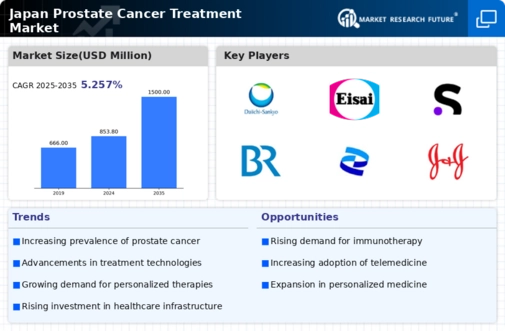Aging Population
Japan's aging population is a significant demographic factor influencing the prostate cancer-treatment market. As life expectancy increases, the prevalence of age-related diseases, including prostate cancer, is also rising. Currently, approximately 30% of prostate cancer cases occur in men aged 70 and above. This demographic shift necessitates tailored treatment approaches and increased healthcare resources to manage the growing patient population. The healthcare system is adapting to these changes by focusing on geriatric oncology, which emphasizes the unique needs of older patients. Consequently, the aging population is a crucial driver for the prostate cancer-treatment market, prompting healthcare providers to develop specialized treatment protocols.
Rising Incidence Rates
The prostate cancer-treatment market in Japan is experiencing growth due to the increasing incidence rates of prostate cancer. Recent statistics indicate that prostate cancer is the most commonly diagnosed cancer among men in Japan, with an estimated 100,000 new cases reported annually. This rising trend necessitates the development and availability of effective treatment options, thereby driving market expansion. As awareness of prostate cancer increases, more men are seeking screening and treatment, which further fuels demand. The healthcare system in Japan is adapting to these changes, leading to innovations in treatment modalities. Consequently, the rising incidence rates are a critical driver for the prostate cancer-treatment market, prompting both public and private sectors to invest in research and development of new therapies.
Government Initiatives and Funding
Government initiatives play a pivotal role in shaping the prostate cancer-treatment market in Japan. The Japanese government has implemented various programs aimed at improving cancer care, including funding for research and public awareness campaigns. For instance, the Ministry of Health, Labour and Welfare allocates substantial budgets to cancer research, which has led to advancements in treatment options. In 2025, the government is expected to increase funding by approximately 15%, reflecting its commitment to combatting cancer. These initiatives not only enhance treatment accessibility but also encourage pharmaceutical companies to invest in innovative therapies. As a result, government support is a significant driver of growth in the prostate cancer-treatment market, fostering an environment conducive to medical advancements.
Technological Advancements in Treatment
Technological advancements are transforming the landscape of the prostate cancer-treatment market in Japan. Innovations such as robotic-assisted surgeries, advanced imaging techniques, and targeted therapies are becoming increasingly prevalent. For example, the introduction of robotic surgery has improved surgical outcomes and reduced recovery times for patients. Additionally, the market is witnessing a surge in the development of novel therapies, including immunotherapy and hormone therapy, which are showing promising results in clinical trials. The integration of artificial intelligence in diagnostics and treatment planning is also gaining traction. These technological advancements not only enhance treatment efficacy but also improve patient experiences, making them a vital driver for the prostate cancer-treatment market.
Increased Patient Awareness and Education
Increased patient awareness and education regarding prostate cancer are driving growth in the prostate cancer-treatment market in Japan. Campaigns aimed at educating the public about the risks and symptoms of prostate cancer have led to more men seeking early diagnosis and treatment. Surveys indicate that awareness levels have risen by approximately 25% over the past five years, resulting in higher screening rates. This shift in patient behavior is encouraging healthcare providers to offer more comprehensive treatment options. Furthermore, educational initiatives are fostering discussions about treatment choices, empowering patients to make informed decisions. As a result, heightened awareness and education are significant drivers of the prostate cancer-treatment market, influencing both demand and treatment approaches.





















Leave a Comment